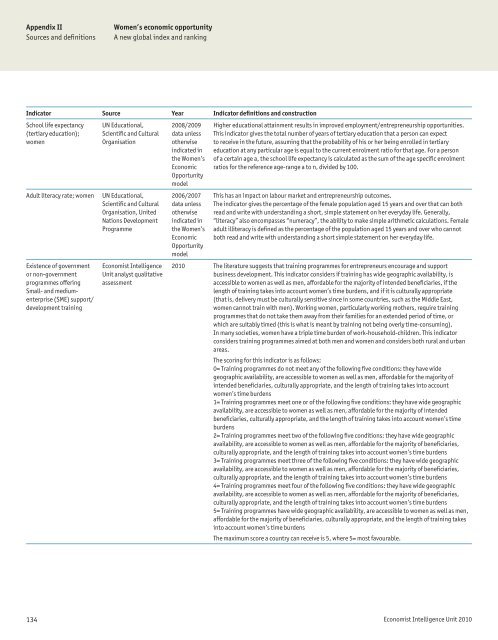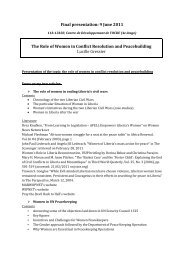Women's Economic Opportunity Index - Economist Intelligence Unit
Women's Economic Opportunity Index - Economist Intelligence Unit
Women's Economic Opportunity Index - Economist Intelligence Unit
- No tags were found...
You also want an ePaper? Increase the reach of your titles
YUMPU automatically turns print PDFs into web optimized ePapers that Google loves.
Appendix IISources and definitionsWomen’s economic opportunityA new global index and rankingIndicator Source Year Indicator definitions and constructionSchool life expectancy(tertiary education);womenAdult literacy rate; womenExistence of governmentor non-governmentprogrammes offeringSmall- and mediumenterprise(SME) support/development trainingUN Educational,Scientific and CulturalOrganisationUN Educational,Scientific and CulturalOrganisation, <strong>Unit</strong>edNations DevelopmentProgramme<strong>Economist</strong> <strong>Intelligence</strong><strong>Unit</strong> analyst qualitativeassessment2008/2009data unlessotherwiseindicated inthe Women’s<strong>Economic</strong><strong>Opportunity</strong>model2006/2007data unlessotherwiseindicated inthe Women’s<strong>Economic</strong><strong>Opportunity</strong>modelHigher educational attainment results in improved employment/entrepreneurship opportunities.This indicator gives the total number of years of tertiary education that a person can expectto receive in the future, assuming that the probability of his or her being enrolled in tertiaryeducation at any particular age is equal to the current enrolment ratio for that age. For a personof a certain age a, the school life expectancy is calculated as the sum of the age specific enrolmentratios for the reference age-range a to n, divided by 100.This has an impact on labour market and entrepreneurship outcomes.The indicator gives the percentage of the female population aged 15 years and over that can bothread and write with understanding a short, simple statement on her everyday life. Generally,“literacy” also encompasses “numeracy”, the ability to make simple arithmetic calculations. Femaleadult illiteracy is defined as the percentage of the population aged 15 years and over who cannotboth read and write with understanding a short simple statement on her everyday life.2010 The literature suggests that training programmes for entrepreneurs encourage and supportbusiness development. This indicator considers if training has wide geographic availability, isaccessible to women as well as men, affordable for the majority of intended beneficiaries, if thelength of training takes into account women’s time burdens, and if it is culturally appropriate(that is, delivery must be culturally sensitive since in some countries, such as the Middle East,women cannot train with men). Working women, particularly working mothers, require trainingprogrammes that do not take them away from their families for an extended period of time, orwhich are suitably timed (this is what is meant by training not being overly time-consuming).In many societies, women have a triple time burden of work-household-children. This indicatorconsiders training programmes aimed at both men and women and considers both rural and urbanareas.The scoring for this indicator is as follows:0= Training programmes do not meet any of the following five conditions: they have widegeographic availability, are accessible to women as well as men, affordable for the majority ofintended beneficiaries, culturally appropriate, and the length of training takes into accountwomen’s time burdens1= Training programmes meet one or of the following five conditions: they have wide geographicavailability, are accessible to women as well as men, affordable for the majority of intendedbeneficiaries, culturally appropriate, and the length of training takes into account women’s timeburdens2= Training programmes meet two of the following five conditions: they have wide geographicavailability, are accessible to women as well as men, affordable for the majority of beneficiaries,culturally appropriate, and the length of training takes into account women’s time burdens3= Training programmes meet three of the following five conditions: they have wide geographicavailability, are accessible to women as well as men, affordable for the majority of beneficiaries,culturally appropriate, and the length of training takes into account women’s time burdens4= Training programmes meet four of the following five conditions: they have wide geographicavailability, are accessible to women as well as men, affordable for the majority of beneficiaries,culturally appropriate, and the length of training takes into account women’s time burdens5= Training programmes have wide geographic availability, are accessible to women as well as men,affordable for the majority of beneficiaries, culturally appropriate, and the length of training takesinto account women’s time burdensThe maximum score a country can receive is 5, where 5= most favourable.134 <strong>Economist</strong> <strong>Intelligence</strong> <strong>Unit</strong> 2010




